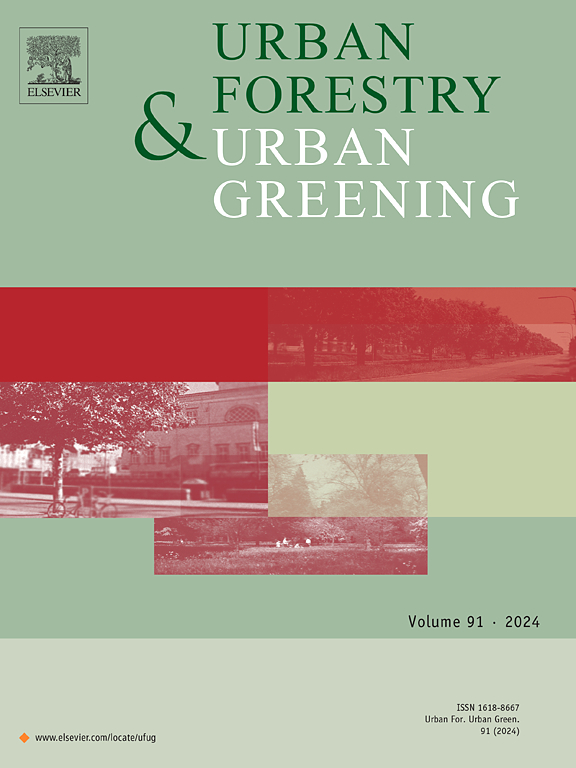Climate drivers of dieback in Mediterranean urban pine forests
IF 6.7
2区 环境科学与生态学
Q1 ENVIRONMENTAL STUDIES
引用次数: 0
Abstract
Droughts trigger forest dieback worldwide, but these events are still understudied in cities. However, conditions of urban forests can aggravate drought stress due to heat island effects, poor growing conditions or lack of management. We investigated a recent dieback event affecting four Pinus halepensis Mediterranean forests located in Málaga, south eastern Spain. We sampled declining (D) and non-declining (ND) trees showing high and low defoliation levels, respectively, and measured their diameter, stem water content (SWC) and radial growth. We used dendrochronology to obtain basal area increment (BAI) series in 40 trees per forest corresponding to D and ND trees growing in N- and S-oriented slopes. These data were correlated with climate variables, teleconnection indices such as the North Atlantic Oscillation (NAO) index and a drought index. Remote sensing indices were used to evaluate changes in cover and greenness. We found that D trees significantly grew more than ND trees in three out of four forests, regardless slope orientation. However, D trees showed a stronger growth decline in the past 10 years and lower SWC than ND trees. Growth was enhanced by high precipitation in the prior December and high minimum temperatures in April. Long winter droughts constrained growth. The dieback was triggered by very warm and dry conditions starting in the winter 2021–2022 and leading to sharp declines in cover and growth from 2022 to 2024. Such dry winter conditions were linked to positive NAO phases. Fast-growing trees with lower SWC were prone to show dieback in response to severe and long winter droughts. These two characteristics could be further explored as early-warning signals of dieback and tree death. Adaptive urban silviculture should consider thinning but also planting tree and shrub species showing higher drought tolerance.
地中海城市松林枯死的气候驱动因素
干旱在世界范围内引发森林枯死,但这些事件在城市中仍未得到充分研究。然而,由于热岛效应、生长条件差或缺乏管理,城市森林的条件可能加剧干旱压力。我们调查了最近发生在西班牙东南部Málaga的四个地中海松林的枯死事件。我们分别采集了落叶程度高和低的凋落树(D)和非凋落树(ND),并测量了它们的直径、茎含水量(SWC)和径向生长。利用树木年代学方法,获得了生长在N、s向坡上的D、ND树木对应的40株/林的基底面积增量(BAI)序列。这些数据与气候变量、北大西洋涛动(NAO)指数和干旱指数等远相关指数相关。利用遥感指数评价植被盖度和绿化率的变化。我们发现,无论坡向如何,四种森林中有三种的D树生长显著高于ND树。然而,D树在过去10年中表现出更强的生长下降,SWC低于ND树。前12月的高降水和4月的高最低气温促进了生长。漫长的冬季干旱限制了生长。枯死是由2021年至2022年冬季开始的非常温暖和干燥的条件引发的,导致2022年至2024年期间覆盖和增长急剧下降。这种干燥的冬季条件与正的NAO相位有关。较低SWC的速生乔木在严重和漫长的冬季干旱中容易出现枯死。这两个特征可以作为枯死和树木死亡的预警信号进一步探讨。适应性城市造林应考虑疏林,但也应种植耐旱性较高的乔灌木物种。
本文章由计算机程序翻译,如有差异,请以英文原文为准。
求助全文
约1分钟内获得全文
求助全文
来源期刊

Urban Forestry & Urban Greening
FORESTRY-
CiteScore
11.70
自引率
12.50%
发文量
289
审稿时长
70 days
期刊介绍:
Urban Forestry and Urban Greening is a refereed, international journal aimed at presenting high-quality research with urban and peri-urban woody and non-woody vegetation and its use, planning, design, establishment and management as its main topics. Urban Forestry and Urban Greening concentrates on all tree-dominated (as joint together in the urban forest) as well as other green resources in and around urban areas, such as woodlands, public and private urban parks and gardens, urban nature areas, street tree and square plantations, botanical gardens and cemeteries.
The journal welcomes basic and applied research papers, as well as review papers and short communications. Contributions should focus on one or more of the following aspects:
-Form and functions of urban forests and other vegetation, including aspects of urban ecology.
-Policy-making, planning and design related to urban forests and other vegetation.
-Selection and establishment of tree resources and other vegetation for urban environments.
-Management of urban forests and other vegetation.
Original contributions of a high academic standard are invited from a wide range of disciplines and fields, including forestry, biology, horticulture, arboriculture, landscape ecology, pathology, soil science, hydrology, landscape architecture, landscape planning, urban planning and design, economics, sociology, environmental psychology, public health, and education.
 求助内容:
求助内容: 应助结果提醒方式:
应助结果提醒方式:


